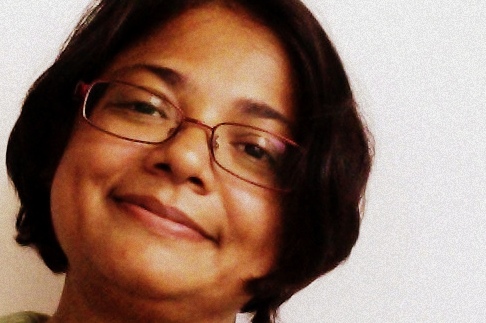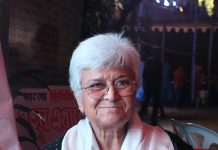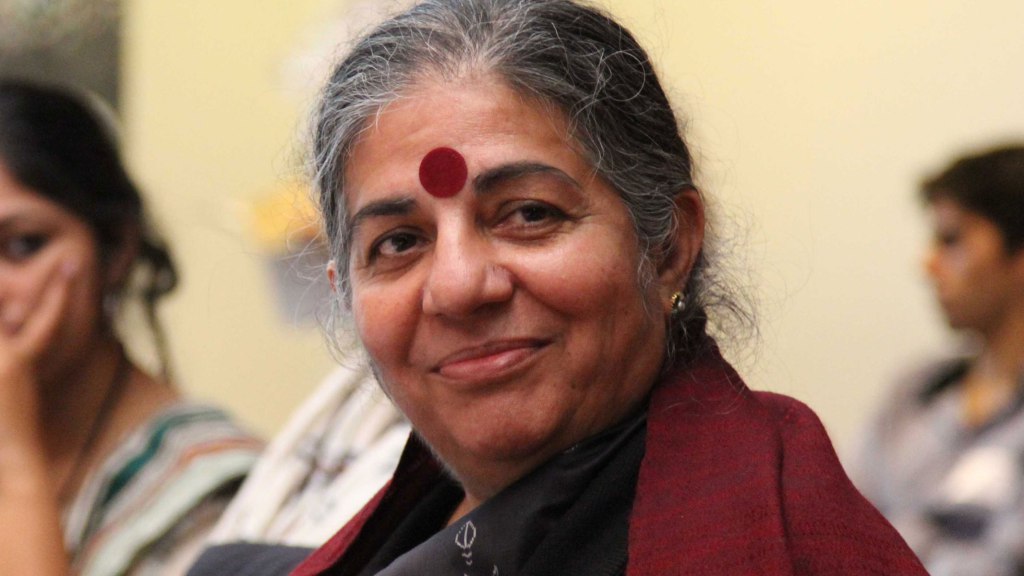From Literature to Critical Pedagogy
Ananya Dasgupta teaches literatures of the British renaissance and writing in the English Department at Shiv Nadar University. She is also an art photographer and poet. She is the author of Between Sure Places, a book of poems that came out in 2015.
As we Convey with her, we find a series of penetrating reflections on literature, education and pedagogy.
In your own personal life trajectory , how have you seen literature, its meaning and significance to other domains of social life?
The summer holidays of my childhood were spent at my grandparent’s house in Patna, and I distinctly remember the summer my world changed. My grandparents’ neighbors had invited us over for lunch, and in the course of hanging around there I discovered a cupboard full of books in the living room. I picked up one book and started reading it. That cupboard became my lending library for the summer. I was given permission to read a book, return it there and borrow another one when I was done. It wasn’t supervised and I read all kinds of things going from one end of the shelf to the other just because I could. I had no context, introduction or preparation; I ate up the books. I remember the sensation of inhabiting two worlds: one which was my immediate outside and another opening up inside my head. It didn’t take me long to understand that the access to the imaginative world of literature was a backdoor entry back into the reality of my immediate surrounding.
My sense of immediacy expanded to geographies and realities that nuanced the shape of the bit of the world I physically occupied. To me the value of literature is not something that needs to be carried over to other disciplines of study or domains of social life, literature draws its significance for already being about everything that concerns us. What we read makes sense because we connect it to the world around us and the world around us makes better sense because we read. For me Pablo Neruda’s poetry makes Rohit Vemula’s letter and death that much more poignant and sharp.
How do you think literature can be used as a tool for critical pedagogy, and what do you think are the limitations in the way it is being seen in our school and universities today in India?
If we understand “critical pedagogy” to mean ways to teach critical thinking and by critical thinking we mean the ability to formulate and think through a problem dispassionately and logically, then what better tool to teach it with than literature? Literature that endures is usually one that embodies the complexities of its times. For students to grasp complexity of thought if we have at our use not just dispassionate logic but also imagination and affect, we have all the elements with which to think humanely and wholely. Critical thought is also about putting oneself intellectually in places of disagreement and experiencing what one is not comfortable or familiar with, literature lets you do that. Conversations that emerge from disagreement and difference is critical to how we grow as thinking people. For example, to grasp what is going on with Hamlet, a character not so easy to access or relate to, requires students to reach beyond the comfort zone of easy familiarity with time and place and make an effort to make sense. That effort to understand something that is not accessible is important to critical pedagogy.
I think Indian schools and universities can be more adventurous and playful with their literature curriculum, and by this I don’t mean throw out everything from the Anglo-American canon and read only translations of vernacular literature and graphic novels (though by all means read those too). What I mean by adventure is to re-imagine which texts can sit with others and what is the renewed logic for their inclusion. I’d put Hamlet next to the stories of Manto and the dystopic fiction of Margaret Atwood to see what happens. I think the idea of the set syllabi with a fixed common exam is the biggest limitation of the Indian school and university system because it gets in the way of creative teaching and learning.
Literature throughout the world has been shaped by socio-cultural movements in society: how do you think changes in post-independent India have impacted the quality of literary creations? Moreover, how would you see the role of globalization and pertinent market forces change the nature of literary works today?
Speaking just of the English language literature that is being produced, the difference between the generation that wrote pre-Independence and the ones that have written since and continues to is one of growing confidence and ownership. Writers write with a sense of owning the language in all its local flavors and what they write about also comes from being invested in the spaces they inhabit. If we put Amitav Ghosh’s Sea of Poppies next to R.K Narayan’s Swami and Friends it becomes easier to answer both parts of your question. Just at the level of language, Narayan’s strength is the ease he brings into his use of a English, a foreign language, to tell a local story. Ghosh recreates English with Bengali and Bhojpuri, with the confidence and lyricism not available to Narayan and the canvas of his story is global as it moves between places and the seas that connect America, British India and China.
Literature has always been global in some sense, and has much more implicit movement in it, than we give credit for when we talk about the economic globalization of the twentieth and twenty-first centuries. If we look at the epics of just about any culture, we find that they are predicated on movement and on crossing boundaries. Having said that, the global markets of reading audiences and cultural transfer, in the great age of immigration that the twenty-first century will likely be remembered as, is certainly influencing what what we get to read and who is canonized. The phenomenon of the literature festivals, the burgeoning of the e-book business, the boost to the enterprise of translation – all point to greater conversation and exchange between writers and better access for the reading public. But the compulsions of the market is always only one element in the production and consumption of enduring literature, for instance the life of literature on the internet is complicating questions of what endures and where. While the market forces may decide that there is no market for poetry, it is not as if poets have gone out of business. They have simply shifted venue. The markets will figure that out and rush in to cash in on that sooner or later.
As a keen photographer and writer, how do you view the present school system in India with its syllabus bound structure and regimented outlooks? What according to you are the most pertinent challenges in our times?
It is interesting that you connected my photography and writing. I took up photography at a time in graduate school when I was going through an extended writer’s block and found myself frustratingly paralyzed and staring into blank word documents that stared blankness back into my very sense of being. I had just bought myself a cheap digital camera and I took to photographing everything in my house and neighborhood and all my friends like my life depended on it. And at that point it did. Social networking came to my rescue and I joined some online photography groups where I obsessively posted photos and studied what the professionals were posting. In a short time my work got picked up and appreciated and gave me a place for conversation and a sense of return. I thought about composition, connections, distortion, layering images for complexity, having a voice and vision — all the things I was supposed to be doing in my writing. It carved a way back for me to go back to writing the thing that was defeating me. When I returned to writing, both academic and creative, I returned renewed. My ability to see and compose images gave me insight into the process of writing and get past the writer’s block and really enjoy writing.
This experience has taught me that the best way to learn to do something is not only by doing directly only that. One may do better in maths for having learnt to play an instrument; one may read and write better for having learnt to throw mud on a wheel and shape pots out of them. Schools and universities have very packed time-tables with room for play being reduced. Students learn best by themselves and with peers. They learn a lot more about literature when they get together and direct and act in a school play in addition to having attended a class on how to read a play to figure out what it means. Keeping students tied to classrooms ensures we raise a generation of students that are afraid to think and play. Exam questions of the kind which only test information is another problem with the way the work of formal education has been envisaged and is being executed. The pertinent challenge of our times is to educate students to be able to formulate problems and ask questions so that they don’t take social and political structures as immutable destiny.
In the broadest sense of the term ‘Humanities’ is seen only second to Technical/skill based education in a market oriented economy such as our’s, where do you think such an outlook will take us in the longer run? What according to you are the implications of the degradation of social sciences?
Let’s take an example: Shiv Nadar University, where I teach, we have, among others, a school of Engineering – a discipline perceived to train students to be ready for the market right after graduation. The curriculum at SNU is such that Engineering students are required to take courses in the school of humanities and social sciences. So engineers at SNU can take elective courses in literature, sociology, economics, archaeology, history, dance, painting, theatre, film-making and so on. When the campus placement interviews happen, students who have been doing well in the electives seem to do better in the interviews. So even the market actually prefers their professionals in management or engineering to be able to think, understand and express themselves in a manner that the social sciences and humanities specialize in training students to do. { I really enjoy having engineering and science majors in my class and I teach them difficult poetry such as Edmund Spenser’s Faerie Queene as I am currently doing and I wait for the glint in their eyes when I know they have got it. The division between technical education and humanities education is a false one and we have to put in our might to break it}. Higher education in India is at a moment of great change. The next National Education Policy is due and my hunch is that it will reflect some changes which weaken this distinction that you are pointing at. There is a distinct interest in liberal arts education and inter-disciplinary work at the university level. Degradation of the social sciences implies the lack of freedom to think and speak your mind, it implies a lack in the social mechanisms that can take criticism and debate. And I can’t see this being ultimately true even if there are periods in time and history when it is severely threatened, as it is now.
“Pedagogy and Poetics: Teaching the ghazal in an American Classroom”, tell us more about this creative experiment and why it is important to be innovative as a pedagogue? What sorts of new experiments do you think can be undertaken in our own Indian classrooms?
In my last year in the United States I was hired to teach a course in World Literatures at The College of New Jersey. When I put my syllabus together, I decided to include a unit on the Urdu ghazal in translation. To engage the students, I decided to give them an exercise in actually writing some ghazals in English which followed the strictures of the Urdu form. What followed was an eye-opening experience of teaching where I saw literary and academic methods inform and transform each other. What started out as a culturally alien set of texts became an exercise in ownership and creativity. I found students worked harder to understand how the ghazals worked when they had to write ghazals of their own. In the course, I was inspired to write assignment questions that moved beyond testing knowledge of the texts to helping them make connections between the different texts they were reading. The students actually looked forward to being given assignments. Thinking about what works in a class and what does not, and that can change from year to year and context to context, means the teacher is also constantly on her feet. Innovation in teaching doesn’t only mean including different forms of technology, it means re-thinking the what teaching means. If information on a subject is a mouse-click away, then the goal of a teacher cannot be to impart more information it must be innovated around helping student figure what to do with the information and how to synthesize and use it. The idea is to set a learning goal for the class and feel free to be able to include methods, however unconventional, that might help the class reach it best.
This article is published in The New Leam, March Issue( Vol.2 No.10) and available in print version.
To buy contact us or write at thenewleam@gmail.com
Or visit FlipKart.com
If You Liked the article? We’re a non-profit. Support This Endeavour – http://thenewleam.com/?page_id=964













